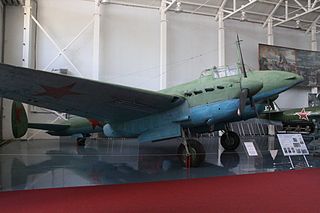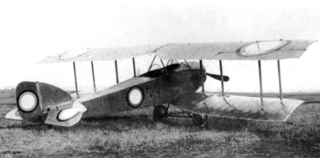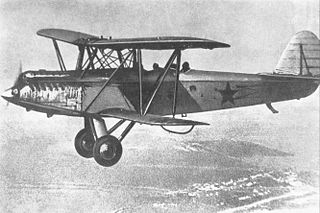Operators
 Russia
Russia
 Soviet Union
Soviet Union
- Soviet Air Force - Taken over from the Imperial Russian Air Force.
| V.I. | |
|---|---|
| General information | |
| Type | Reconnaissance aircraft |
| Manufacturer | Anatra |
| Designer | |
| Number built | 139 |
| History | |
| First flight | 1916 |
The Anatra V.I. (for Voisin-Ivanov, not the Roman numeral VI) was a Russian reconnaissance aircraft of World War I. It was a redesign of the French Voisin III undertaken by Podporuchik Piotr Ivanov in Zhmerynka. The Voisin's fuselage pod was replaced by a streamlined, plywood construction that included an all-new mount for the observer's machine gun and an aluminium firewall between the pilot's cockpit and the aircraft's fuel tank. The wings and landing gear were strengthened as well. Despite the machine's greater weight, it was 20 km/h (12 mph) faster in the air than the Voisin that it was based on, and was quickly ordered into production. In practice, however, the aircraft that reached operational units were poorly built and therefore disliked by their crews.
General characteristics
Performance
Armament

The Petlyakov Pe-2 was a Soviet twin-engine dive bomber used during World War II. One of the outstanding tactical attack aircraft of the war, it also proved successful as a heavy fighter, as a night fighter and as a reconnaissance aircraft. The Pe-2 was, numerically, the most important Soviet bomber of World War II, at their peak comprising 75% of the Soviet twin-engine bomber force. The Soviets manufactured Pe-2s in greater numbers during the war than any other twin-engine combat aircraft except for the German Junkers Ju 88 and the British Vickers Wellington. Several Soviet bloc air forces flew the type after the war, when it became known by the NATO reporting name Buck.

The Kharkiv KhAI-5, was a Soviet reconnaissance and light bomber aircraft, designed in the mid-1930s in the Kharkiv Aviation Institute, under the direction of Iosif Grigorevich Nyeman.
The Tupolev ANT-7, known by the VVS as the Tupolev R-6, was a reconnaissance aircraft and escort fighter of the Soviet Union. The R-6 traces its roots back to early 1928 when the Soviet Air Force needed a long-range multirole aircraft. The requirements were that it could be used for long-range transport, defensive patrolling, reconnaissance, light bombing and torpedo attack.

The Voisin III was a French World War I two-seat pusher biplane multi-purpose aircraft developed by Voisin in 1914 as a more powerful version of the 1912 Voisin L. It is notable for being the aircraft used for the first successful shooting down of an enemy aircraft on October 5, 1914, and to have been used to equip the first dedicated bomber units, in September 1914.

Grigorovich M-5 was a successful Russian World War I-era two-bay unequal-span biplane flying boat with a single step hull, designed by Grigorovich. It was the first mass production flying boat built in Russia.

The Albatros C.XV was a German military reconnaissance aircraft developed during World War I. It was essentially a refinement of the C.XII, which had been put into production in 1918. The war ended before any examples became operational. However, some found their way into civilian hands and flew as transport aircraft in peacetime under the factory designation L 47. Others saw service with the air forces of Russia, Turkey, and Latvia.

The Anatra D or Anade was a two-seat reconnaissance aircraft built in Odessa, Russian Empire and flown during World War I. It was a two-bay biplane of conventional configuration that seated the pilot and observer in tandem, open cockpits. Test flights revealed a number of design flaws, including weak wing structure that would later kill the company test pilot on 21 July 1917 and poor stability. Despite the problems, the aircraft was ordered into production by the Army, and deliveries commenced in May 1916 after revisions had been made to correct the aircraft's centre of gravity in the hope of addressing the worst handling problems. The type continued in limited service after the war, eventually being used as a trainer until about 1919.

The Anatra DS or Anasal was a two-seat reconnaissance aircraft developed from the Anatra D (Anade). It was built in the Anatra factory in Odessa in the Russian Empire and flown during World War I by both sides during the Russian Civil War.

The Polikarpov R-5 was a Soviet reconnaissance bomber aircraft of the 1930s. It was the standard light bomber and reconnaissance aircraft of the Soviet Air Force for much of the 1930s, while also being used heavily as a civilian light transport, some 7,000 being built in total.

The Farman HF.20 and its derivatives were a family of reconnaissance aircraft produced in France shortly before and during the First World War. It was a refined version of the Farman MF.11 "Shorthorn" that did away with the type's distinctive landing skids, and incorporated design features from Henri Farman's designs. It entered service with the French, Belgian and Serbian armies in 1913, and with the British RFC and RNAS shortly after the outbreak of war. The type was also licence-built in the UK by Airco and Grahame-White.

The Heinkel HE 5, produced in Sweden as the Svenska Aero S 5 and nicknamed the "Hansa", was a reconnaissance floatplane built during the 1920s. It was a further development of the HE 1, sharing its same basic configuration as a low-wing, strut-braced monoplane. The HE designation also refers to the monoplane construction, standing for Heinkel Eindecker.

The SPAD S.XII or SPAD 12 was a French single-seat biplane fighter aircraft of the First World War developed from the successful SPAD VII by Louis Béchereau, chief designer of the Société Pour L'Aviation et ses Dérivés (SPAD).
The Junkers J 21 was a reconnaissance aircraft designed in Germany in the early 1920s and produced in the Soviet Union at the Junkers plant at Fili for use by the Soviet Air Force.

Kochyerigin DI-6 was a two-seat fighter biplane produced in the Soviet Union in the 1930s.

The Lebed XII was a Russian military reconnaissance aircraft produced during the First World War for the Imperial Russian Air Force. It was one of the few domestically designed aircraft to see production in Russia during the war, but was based on designs and techniques learned from Lebed's rebuilding of captured German types. The fuselage was a plywood structure of rectangular cross-section with seating for the pilot and observer in tandem, open cockpits. The wings were built around a pine spar and covered in fabric, and the empennage was of welded steel tube with fabric covering.

The LVG C.V was a reconnaissance aircraft produced in large numbers in Germany during World War I.

The Henry Farman HF.30 was a two-seat military biplane designed in France around 1915, which became a principal aircraft of the Imperial Russian Air Service during the First World War. Although it was widely used on the Eastern Front, and by the factions and governments that emerged in the subsequent Russian Civil War, it is not well known outside that context: the HF.30 was not adopted by other Allied air forces, and the manufacturers reused the "Farman F.30" designation for the Farman F.30 in 1917.

The Otto C.I, also known as the Otto KD.15, was a German two-seat biplane reconnaissance and bomber aircraft of the First World War designed and produced by Otto Flugmaschinenfabrik. The C.I was a rare example of an aircraft flown by the Central Powers which had a pusher configuration.
The Voisin VI or Voisin Type 6 was a French pusher biplane bomber aircraft of World War I.
The Mosca-Bystritsky MBbis was a fighter aircraft developed and used by the Imperial Russian Air Service during the First World War.